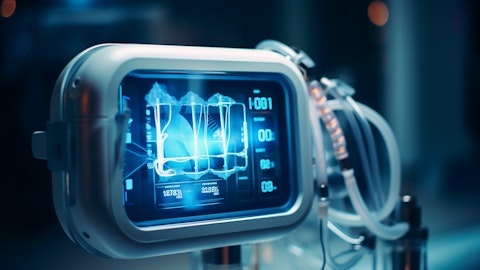Steve MacMillan: Yes. I think the magic of our international business is — it’s a lot of individual products in individual countries that we’ve been building kind of market access capabilities and everything over the years. And while there’s no one that’s driving it. We’ve just got a series of different products and different geographies that are really building momentum. And a lot of them in kind of the surgical and interventional space. Certainly, we’re getting very excited about our Surgical business and its opportunity internationally, both what we’ve been doing with our own sales forces plus we did mention we acquired our distributor in the Nordics. So continuing to go — feel very well there. And then it’s just — you get different times.
The fact we got our digital cytology approved, internationally, that’s been going very well in Western Europe. So it’s just this collection of the different franchises, the different geographies building over time. And I think the magic is Andrew, from the years in the past, we always said we’re going to be building these businesses internationally, not by showing up 1 day and saying, hey, we’re going to dramatically expand our sales forces and take a year off on profit growth. We’ve been making the investments all along. And then as certain products launch in certain countries, then we use that funding to fund the next year and keep building. So it’s really just this inexorable building of success.
Operator: Our next question come from Andrew Petrone with Mizuho Securities.
Unidentified Analyst: This is Brad Davis [ph] on for Anthony. — not another Andrew but — talk on the Breast Health business. I figure — whenever we see you guys make a move in Breast Health, obviously, core competency at which you’re paying attention. The one to kind of hear your strategic rationale on the Endomag acquisition, why you see now as kind of a time to get bigger on the procedural side of the business and if we should expect kind of further moves to cover the swap and the continuum, if there’s any other assets that you think that you’d like to have in that portfolio?
Steve MacMillan: Yes. I think the biggest piece is it’s just a continuation of what we’ve been doing over the last 5, 6 years where we’ve tried to build, especially the gantry business and build out across the breast care continuum. So into biopsies and into interventional techniques. So as we’ve been building our own markers business, this has been an area we’ve been looking. We got into localizer a few years back. We’ve been doing both organic, inorganic. And the timing on this one really is driven by the opportunity to pick up Endomag. They’ve been a business we’ve been tracking for quite some time that we liked a lot and the opportunity finally became available to grab them. Thank you. But yes, just continuing on what we’ve been doing.
Unidentified Analyst: Got it. That’s helpful. And then just to stay on the breast business, you recently called out some of the life cycle in the boxes 2014 launch time frame. So maybe getting to the 9-, 10-year time frame. Can you just remind us, I guess, the life span on these devices and how Hologic plans to kind of best monetize the upgrade replacement opportunity and also if this is part of the rationale on timing of any new systems software and product enhancements.
Karleen Oberton: Yes. I would say we’ve been very intentional into really smooth out that business and really move away from the boom bust of a life cycle replacement — replacement cycle. And as we’ve talked about, we’ve had many software and other upgrades to the gantry system over the past several years, all of which have been backwards compatible to that installed base. The customers have been able to get improvements and upgrades along the way. They don’t have to wait for that next gen gantry. But having said that, we certainly have something in development but that’s what we’ll be talking about later, probably in ’25.
Operator: Absolutely. That question will come from Michael Ryskin [ph] with Bank of America.
Unidentified Analyst: This is John [ph] came on for Mike. I think we’ve talked about these numbers before and I was wondering the improved utilization seems to be the main contributor. So I was wondering how the average number of assay used for Panther has been trending, like what percentage of the customers is using more than one assay versus more than 4 assays.
Karleen Oberton: Yes. So I think if we go back to 2019, we would say that less than or about 20% of our customers were running about 4 more assays at the end of that into ’22, that was probably approaching high 30%, maybe 40%. But I think that’s the entire installed base. But I think the other metric I’d look to — point to is the newer Panthers that were placed since April of 2020. So new customers acquired since the pandemic over 90% of those customers are running at least one other assay and over 55% of running at least 2 other assays. So I think that all points to the value, the workflow that our customers see with the Panther instrument in the menu and the long runway ahead to continue to drive utilization on the installed base.
Operator: And this now concludes Hologic’s first [ph] quarter fiscal 2024 earnings conference call. Have a good evening.
Follow Hologic Inc (NASDAQ:HOLX)
Follow Hologic Inc (NASDAQ:HOLX)
Receive real-time insider trading and news alerts



